3,000 Eggs Gathered at Easter Egg Hunt
- Details
- Written by: Joanne Wallenstein
- Hits: 1261
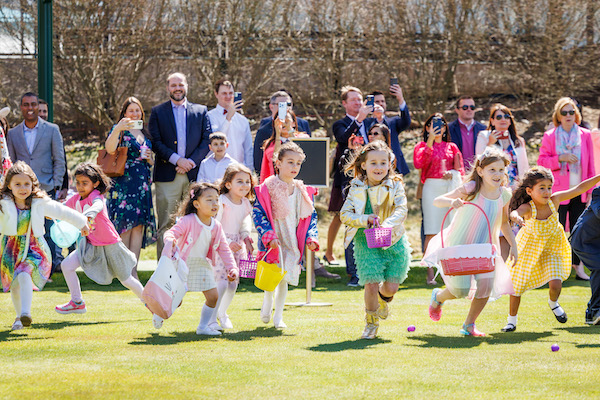 Over 3,000 eggs were picked up from the driving range during the annual Scarsdale Golf Club Easter egg hunt on Sunday March 31.
Over 3,000 eggs were picked up from the driving range during the annual Scarsdale Golf Club Easter egg hunt on Sunday March 31.

Over 150 kids participated with groups of toddlers ages 4 and under, another with kids 5-7 years old and another for kids ages 8 and up.
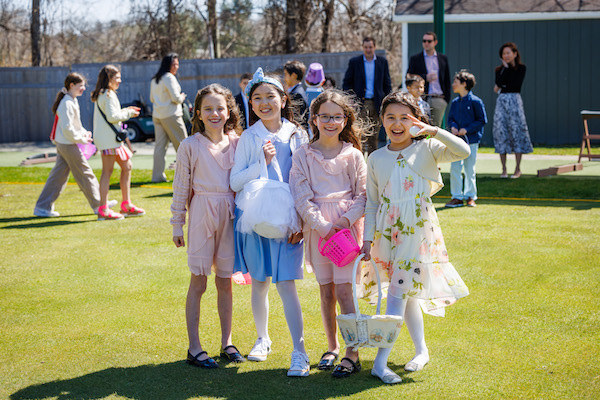
The Easter Bunny kicked off the event and posed for photos with kids and families before the dinner buffet.
The club hosted 500 members and guests for Easter Dinner.
(Photos by Mark Latham)


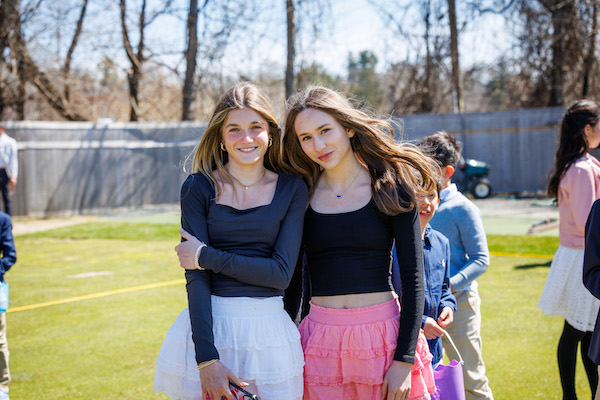


Scarsdale in WWII: Now Free to Watch Online
- Details
- Written by: Joanne Wallenstein
- Hits: 2348
 A blood drive at Scarsdale Golf Club during WWIIOn Tuesday night March 26, the Scarsdale Historical Society held a screening of the film “Scarsdale in World War II,” to a packed audience in the Scott Room of Scarsdale Library. The movie was created and released by Scarsdale residents in 1946 and chronicles how Scarsdalians united and rallied in support of the war effort in the 1940s. It was produced and screened as part of a fundraising campaign for Jewish refugee children.
A blood drive at Scarsdale Golf Club during WWIIOn Tuesday night March 26, the Scarsdale Historical Society held a screening of the film “Scarsdale in World War II,” to a packed audience in the Scott Room of Scarsdale Library. The movie was created and released by Scarsdale residents in 1946 and chronicles how Scarsdalians united and rallied in support of the war effort in the 1940s. It was produced and screened as part of a fundraising campaign for Jewish refugee children.
The original 16mm film was found in storage at the Scarsdale Public Library, and all 1,200 feet of film has been digitized and preserved by the Scarsdale Historical Society. This historic treasure presents a stunning, visual testimony of Scarsdale life in the 1940’s. The footage captures Scarsdale’s landmarks as they appeared almost 80 years ago, including the only-known footage of some sites that no longer exist.
Proceeds from the screening of this film went to a national interfaith organization named “Children to Palestine.” The meaning behind this name requires some explanation, as it could cause some confusion in today’s context. When Jewish children were orphaned and displaced during the Holocaust, one of the few options for resettling them was the area then known as Palestine - before Israel became a nation in 1948. Moved by the plight of Jewish children, Scarsdale residents of all backgrounds united to rescue them from the “land of persecution” and bring them to a “Land of Promise.”
The Scarsdale branch of “Children to Palestine” was founded by two Scarsdale residents: Dorothy Silverstone (of 6 Richbell Close) and Susan Bennett (or 10 Elmdorf Drive). A Junior Committee was formed, and they sponsored the making of this film with the support of Dorothy Silverstone’s husband, Murray Silverstone, who was the President of 20th Century Fox. They were a very philanthropic couple, and it’s worth noting that with all of Murray’s accomplishments in the movie industry, this film was named in his obituary as one of his proud accomplishments.
It turns out that former Mayor Jane Veron was related to Silverstone. Veron explained, “Murray and Dorothy are my great uncle and aunt. My grandfather Emanuel Silverstone (my mom’s dad) also worked at 20th Century Fox. He would tell us stories about famous actresses like Elizabeth Taylor and Shirley Jones. Murray was his older brother. As a child, we used to visit Murray and Dorothy’s home/barn on Richbell Close for family events. We were regaled with stories from their days in the motion picture business.”
The Historical Society conducted research and detective work to identify some of the film locations and prominent residents, and provided this information in captions to help the audience connect and better understand the film. The film has now been posted online and is free to watch!
See wonderful footage of a party at Fox Meadow Tennis Club the night of the attack on Pearl Harbor, women of Scarsdale who swung into action for the war effort and sad stories of Scarsdale’s young men who did not return from the war.
The film was produced by stage producer Julian Olney and narrated by renowned broadcaster Lowell Thomas and is well worth watching here.
Discovering Your Second Act
- Details
- Written by: Joanne Wallenstein
- Hits: 2026
 Zibby OwensHow do we reinvent ourselves when it’s time to pivot? Are there ways to repurpose what we know and use seemingly-unrelated experiences as the basis for our next gig? That was the subject of a panel discussion featuring three authors and moderated by Scarsdale “mompreneur” Pamela Pekerman held at the Scarsdale Library last Thursday night, March 14th.
Zibby OwensHow do we reinvent ourselves when it’s time to pivot? Are there ways to repurpose what we know and use seemingly-unrelated experiences as the basis for our next gig? That was the subject of a panel discussion featuring three authors and moderated by Scarsdale “mompreneur” Pamela Pekerman held at the Scarsdale Library last Thursday night, March 14th.
Zibby Owens, a mother of four, hosts the podcast, Moms Don’t Have Time to Read Books, runs her own publishing house Zibby Books, owns a bookstore in Santa Monica and recently wrote her own novel, Blank.
Joanne Lipman, a journalist who was the editor in chief at USA Today, founding editor of Condé Nast Portfolio and started the Wall Street Journal’s weekend edition, shared her findings from the research she did for her most recent book, Next! The Power of Reinvention in Life and Work.
Amy Shoenthal, a branding and marketing expert, discussed her book, The Setback Cycle: How Defining Moments Can Move Us Forward. She is a contributor to ForbesWomen and the Harvard Business Review and will give her first TEDx talk this spring.
Lipman explained the genesis of her book, which she worked on during COVID, “I wanted to look at this idea when we were reprioritizing our lives and the relationship of work to our lives,” she said. “I interviewed people who went through transformations. Women are masters of reinvention, often by necessity. We hit the glass ceiling and don’t have the same opportunities.” In fact, one of Next’s subjects is former Scarsdale Mayor Jane Veron, who left a corporate position to raise her three daughters, but went on to create The Acceleration Project, an organization that uses experienced volunteers to advise local entrepreneurs.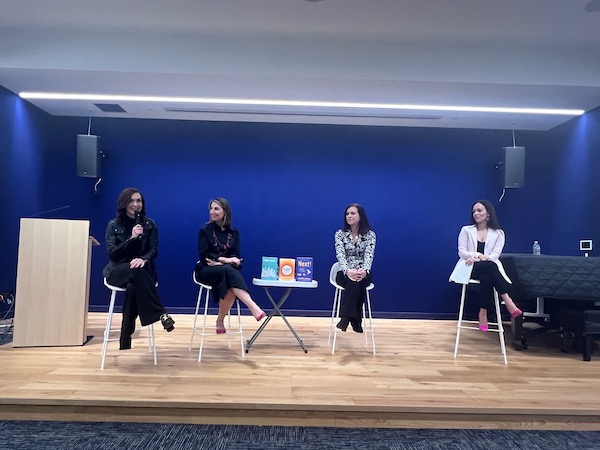 Panelists on stage
Panelists on stage
All three women talked about staying in the fray, and figuring out how to silence your inner critics.
Asked how she combats negative self-talk when something goes wrong, Amy Shoenthal said, “Your inner critic can get loud when you have a setback, but you need to fight the self-doubt by conjuring up an “inner hype” voice or relying on an imaginary cheerleader.
Zibby Owens spoke about the value of trips and falls saying, “Most of the time you get over the setback and end up in a better place than you were before.”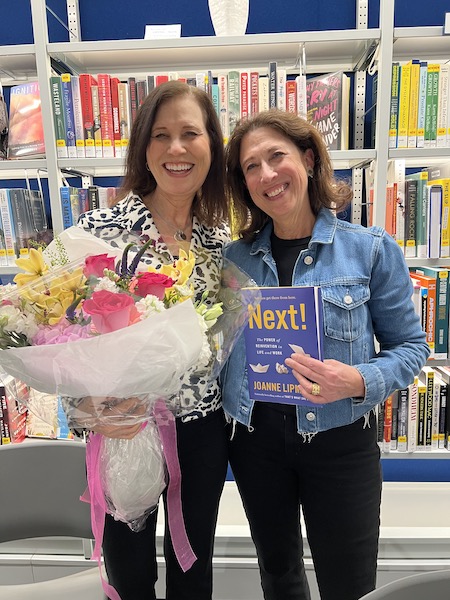 Joanne Lipman and Elyse Klayman
Joanne Lipman and Elyse Klayman
Lipman defined what she calls the four S’s of reinvention, gleaned from those she interviewed for her book: Search. Struggle. Stop. Solution. These words, she said, can be used as a roadmap when looking for a new direction.
During the process, Lipman recommended calling on an expert companion or person who knows you well and can reflect your strengths and talents back to you. This companion can be a friend, a personal coach, or a psychologist. She said, “It’s good to have one, and to be one to someone else.”
Asked how to give yourself space to explore, Shoenthal said, “Don’t freeze. Don’t get in a spiral of resentment, blame and shame. Thaw yourself out. Explore your curiosity–play a team sport or volunteer.”
Owens advised, “Just keep doing what you’re interested in. It will pay off in the end. Persistence is what makes anything a success. Don’t stop trying. Nothing you go through is wasted. Even if it does not work out.”
The three, along with moderator Pamela Pekerman offered positive messages and energy to those who were hoping to find new careers or life paths. Following the talk, the panelists answered questions and signed books sold by Bronx River Books.
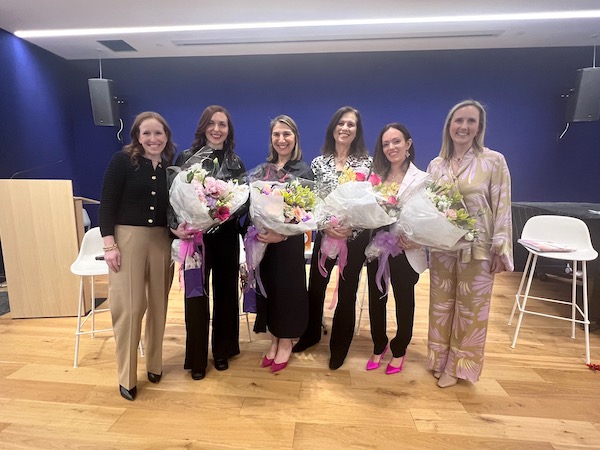 Panelists with Stacey Mayer and Nancy Kaplan
Panelists with Stacey Mayer and Nancy Kaplan

Tickets Now on Sale for the 2024 Scarsdale Music Festival on June 1
- Details
- Written by: Joanne Wallenstein
- Hits: 2256
 Tickets are now on sale for the 2024 Scarsdale Music Festival (SMF), presented by Morgan Stanley. The 4th Annual Festival, hosted by the Scarsdale Business Alliance (SBA), will take place rain or shine on Saturday, June 1st, from 12-6pm in Scarsdale Village, and will benefit Daniel’s Music Foundation.
Tickets are now on sale for the 2024 Scarsdale Music Festival (SMF), presented by Morgan Stanley. The 4th Annual Festival, hosted by the Scarsdale Business Alliance (SBA), will take place rain or shine on Saturday, June 1st, from 12-6pm in Scarsdale Village, and will benefit Daniel’s Music Foundation.
The SBA is thrilled to announce this year’s line-up of amazing talent who will perform on two main stages throughout the day as well as an all new acoustic stage. Twelve bands from Scarsdale and the greater Tri-State area were chosen through an extensive selection process from over 70 submitted applicants.
● Artia Tobia: A NYC-based artist who infuses his Americana roots with a modern edge, delivering heartfelt lyrics and soulful melodies that resonate with audiences across genres.
● Conversing with Oceans: A fully evolved indie rock band based in Westchester looking to their rock past to explore new sounds and musical landscapes. Their debut LP “WILD / DREAMS” is a dedicated rock album at heart, displaying what these four musicians are capable of together.
● The Del Bocas: A Scarsdale based-band together for over ten years, who see themselves as sort of a "wild jukebox" - with a large repertoire of songs from the 60’s to today.
● Doni Nicole and the DNE Band: A multifaceted artist, entrepreneur, and mother, based in New Rochelle, whose music spans various genres, from gospel to world music. Notable achievements include singing background for iconic artists like Patti Labelle and releasing chart-topping singles such as "New Joy2" and "Drummer Boy," recognized at the Holiday Music & Film Awards 2022.
● Euphoria: A 5-person band from New York with a unique brand of performance style, entertaining audiences with a refreshing take on beloved songs.
● Hunter Road: A band whose sounds harken back to the days when rock was rock and originality was essential. Drawing influences from Soundgarden, Aerosmith, and other greats, Hunter Road is leading the Rock Renaissance with a timeless sound and style that will take this talented group of artists into the future.
● Lauren Minear: A critically-acclaimed, indie folk-pop singer-songwriter, psychotherapist, and mother based in New York, who draws inspiration from her eclectic background to craft soulful melodies and introspective lyrics that captivate audiences with their authenticity and depth.
● The Men of Soul: A top soul and R&B tribute band on the East Coast. They are a talented, dynamic 3-man vocal group from NYC, accompanied by a 4-piece band bringing Classic and Neo Soul, and R&B music to the stage.
● Rennie Pincus & Friends: A Scarsdale-based band whose recent album, DEAL, explores the music of The Grateful Dead and features very special guests Elliot Easton (The Cars), Jack Petruzelli (Joan Osborne), Matt Rae (Arlen Roth), and Annalyse & Ryan.
● Skyfactor: A NYC/Westchester-based band with members from Scarsdale. Their newest album is entitled "A Thousand Sounds," and they’re the band behind the song "OK" from MTV's hit show “Teen Mom.”
● Trinity: A versatile artist whose eclectic sound seamlessly blends elements of R&B, hip-hop, and pop, captivating audiences with her soulful vocals and introspective lyrics, while also using her platform to advocate for social justice and empowerment.
● Zac Hoina Trio: A dynamic blues trio known for their electrifying live shows, where they skillfully blend raw emotion with authentic blues sounds, captivating audiences with their soulful performances and masterful musicianship.
The 2024 SMF non-profit beneficiary is Daniel’s Music Foundation (DMF), which empowers individuals with disabilities through music education, performance, and socialization. DMF featured performers at this year’s festival include:
● Daniel & Gerry: Daniel Trush (DMF Co-Founder and President) and Gerry Powers (DMF Artistic Director) have been singer/songwriter partners since 2011. Daniel has overcome many challenges since one in five undetected brain aneurysms burst in his head at the age of 12, with music playing an integral role in his recovery. Together, Daniel and Gerry write and perform folk rock songs that focuses on kindness and understanding, with an overall message of acceptance.
● George Dennehy: At age 8 George learned to play the cello. From there, he taught himself the guitar, electric bass, and basic piano. He has overcome many challenges, including his early struggle against death in a Romanian orphanage as a toddler, and believes that every individual has a purpose. In 2012, the Goo Goo Dolls discovered a video of his cover of their song “Iris”, and he was invited to Musikfest to perform. Today he travels the world sharing his story and his music.
● Iolanta Mamatkazina: A NYC based Opera singer, Iolanta has been performing since the age of seven and continues to captivate audiences. Despite her young age, Iolanta has faced the challenge of being underestimated due to her disability. She believes in not judging someone before getting to know them, emphasizing that being recognized as a "just call me by name" artist holds great importance to her. For Iolanta, this is a platform to shatter stereotypes, proving that being blind or disabled doesn’t mean you can’t achieve impossible things.
● Jake Nielsen: a Rocker, blues-guitarist, and international recording artist hailing from Santa Cruz, California. With a musical journey spanning back to the age of 13 and performances since 2010, Jake is no stranger to the stage. For him, being recognized as a "Just Call Me By My Name" artist holds importance because it gives musicians with disabilities a platform to be heard.
To purchase tickets and for more information about the event visit scarsdalemusicfestival.com.

The Scarsdale Business Alliance is thankful to the 2024 SMF event sponsors for their generous support.* Presenting Sponsor: Morgan Stanley; Live Stage Sponsors: Advocate Brokerage Corp. with Pure, Houlihan Lawrence, Pepe Auto Group; Platinum sponsors: Compass, GameChanger, I Am More Scarsdale, M.S. Walker, Scarsdale Improvement Corp., The UPS Store, Party Line Rentals; Gold sponsors: Chase, Do Some Good, Douglas Elliman, DUBCO, Feast & Fettle, Hair Saloon & Cafe, Julia B. Fee Sotheby’s International Realty, The Seas Collective; Silver Sponsors: GameTruck, Meritage, NYS Music, Rudy's Music, ScentFluence, Smile Studio, Unthinkable Comedy, Westchester County Mom. *Sponsors confirmed as of March 8th, 2024.
The Scarsdale Music Festival is an exceptional, family-friendly community event that brings together thousands of people of all ages to celebrate their love of music, food, and community and is a not-to-be missed experience! The SBA is a non-profit organization dedicated to supporting the Village of Scarsdale and its local businesses.
For event information and sponsorship opportunities: www.scarsdalemusicfestival.com
follow us on Instagram and Facebook @scarsdalemusicfestival.
For more information about the Scarsdale Business Alliance: www.scarsdalebusinessalliance.com and follow us on Instagram and Facebook @scarsdalebusiness.
To learn more about Daniel’s Music Foundation: danielsmusic.org.
Schuman Wins Mac N' Cheese Contest
- Details
- Written by: Joanne Wallenstein
- Hits: 4220
 On Sunday, March 3 Ira Schuman won best “Overall” in a Mac N" Cheese Bake Off sponsored by Angel Food East a not-for-profit organization in Kingston, New York.
On Sunday, March 3 Ira Schuman won best “Overall” in a Mac N" Cheese Bake Off sponsored by Angel Food East a not-for-profit organization in Kingston, New York.
This was the first time Schuman entered the contest and he took the award in a field of 30 other contestants including professional chefs and restaurants.
Ira was working from a recipe created by his wife, Assemblymember Amy Paulin, which he modified slightly. It was the first time he entered.
Paulin says, “Ira loves to cook and it occasionally comes out good.”
Pictured at top are Ira Schuman (left) with the woman who won the contest the prior three years and two of Ira's buddies.












